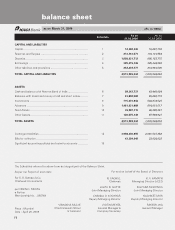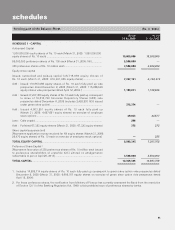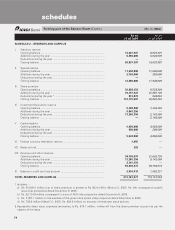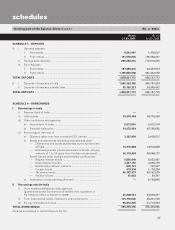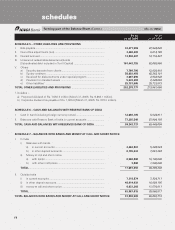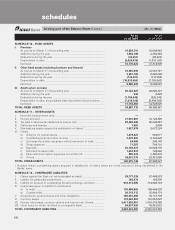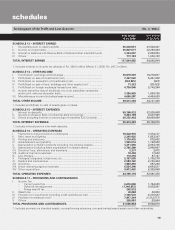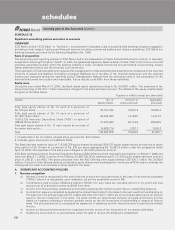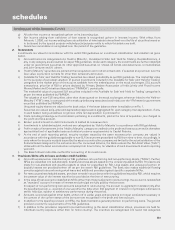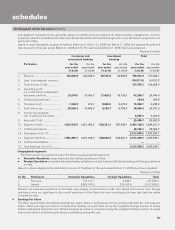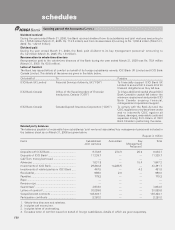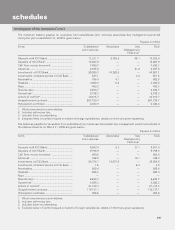ICICI Bank 2006 Annual Report Download - page 71
Download and view the complete annual report
Please find page 71 of the 2006 ICICI Bank annual report below. You can navigate through the pages in the report by either clicking on the pages listed below, or by using the keyword search tool below to find specific information within the annual report.
F12
forming part of the Accounts (Contd.)
schedules
SCHEDULE 18
Significant accounting policies and notes to accounts
OVERVIEW
ICICI Bank Limited (“ICICI Bank” or “the Bank”), incorporated in Vadodara, India is a publicly held banking company engaged in
providing a wide range of banking and financial services including commercial banking and treasury operations. ICICI Bank is a
banking company governed by the Banking Regulation Act, 1949.
Basis of preparation
The accounting and reporting policies of ICICI Bank used in the preparation of these financial statements conform to Generally
Accepted Accounting Principles (“GAAP”) in India, the guidelines issued by Reserve Bank of India (“RBI”) from time to time and
practices generally prevalent within the banking industry in India. The Bank follows the accrual method of accounting, except
where otherwise stated, and the historical cost convention.
The preparation of financial statements requires the management to make estimates and assumptions considered in the reported
amounts of assets and liabilities (including contingent liabilities) as of the date of the financial statements and the reported
income and expenses during the reporting period. Management believes that the estimates used in the preparation of the
financial statements are prudent and reasonable. Future results could differ from these estimates.
Equity issue
During the year ended March 31, 2006, the Bank raised equity capital amounting to Rs. 80,006.1 million. The expenses of the
issue amounting to Rs. 874.1 million have been charged to the share premium account. The details of the equity capital raised
are given in the table below.
Rupees in million except per share data
Details No. of Amount of Aggregate
equity shares share premium proceeds
Fully paid equity shares of Rs. 10 each at a premium of
Rs. 515 per share ........................................................................ 67,787,322 34,910.5 35,588.3
Fully paid equity shares of Rs. 10 each at a premium of
Rs. 488.75 per share1................................................................................................................... 28,894,060 14,122.0 14,410.9
18,618,730 American Depository Share (“ADS”) at aprice of
US$ 26.75 per share 2.................................................................................................................. 37,237,460 22,134.6 22,506.9
Fully paid equity shares of Rs. 10 each issued by exercise of
the green shoe option ................................................................ 14,285,714 7,357.1 7,500.0
Total 148,204,556 78,524.2 80,006.1
1. Unpaid calls of Rs. 0.3 million (Unpaid share premium Rs. 92.4 million).
2. Includes green shoe option of 2,428,530 ADSs.
The Bank had also made an issue of 115,920,758 equity shares (including 6,992,187 equity shares issued by exercise of green
shoe option) of Rs.10 each at a premium of Rs. 270 per share aggregating Rs. 32,457.8 million under the prospectus dated
April 12, 2004. The expenses of the issue were charged to the share premium account.
ICICI Bank had sponsored an American Depositary Shares (ADSs) Offering which opened for participation on March 7, 2005 and
closed on March 11, 2005. In terms of the Offering, 20,685,750 ADSs representing 41,371,500 equity shares had been sold at a
price of US$ 21.1 per ADS. The gross proceeds from the ADS Offering were approximately US$ 436.7million (Rs.19,099.6
million). Pursuant to this offering existing outstanding equity shares were exchanged for newly issued ADSs and accordingly the
offering did not result in an increase in share capital of the Bank.
A. SIGNIFICANT ACCOUNTING POLICIES
1. Revenue recognition
a) Interest income is recognised in the profit and loss account as it accrues except in the case of non-performing assets
(“NPAs”) where it is recognised, upon realisation, as per the prudential norms of RBI.
b) Commissions paid to Direct Marketing Agents (“DMAs”) for auto loans are recorded upfront in the profit and loss
account net of subvention income received from them.
c) Income from hire purchase operations is accrued by applying the implicit interest rate on outstanding balances.
d) Income from leases is calculated by applying the interest rate implicit in the lease to the net investment outstanding on
the lease over the primary lease period. Leases effective from April 1, 2001 are accounted as advances at an amount
equal to the net investment in the lease. The lease rentals are apportioned between principal and finance income
based on a pattern reflecting a constant periodic return on the net investment of outstanding in respect of finance
lease. The principal amount is recognised as repayment of advances and the finance income is reported as interest
income.
e) Income on discounted instruments is recognised over the tenure of the instrument on a constant yield basis.
f) Dividend is accounted on an accrual basis when the right to receive the dividend is established.


